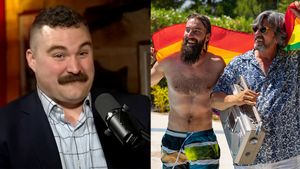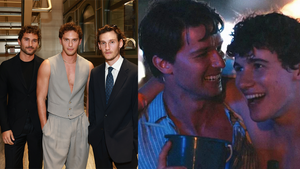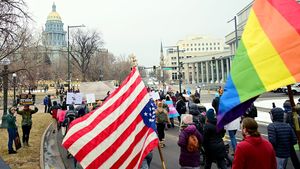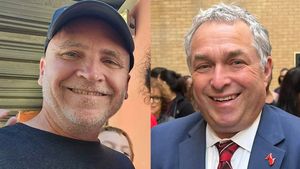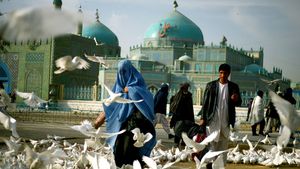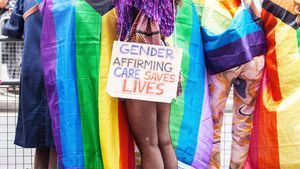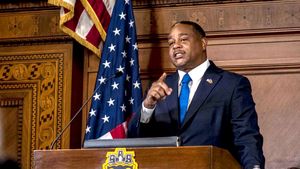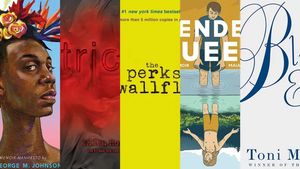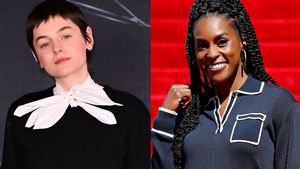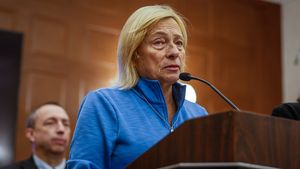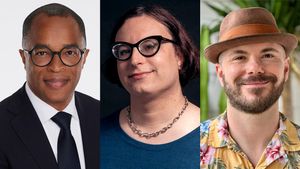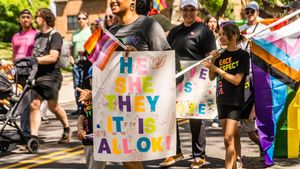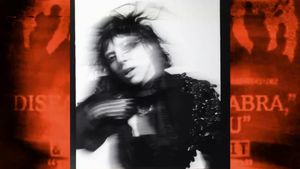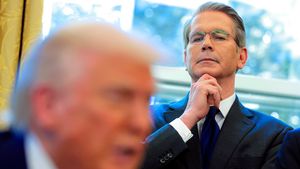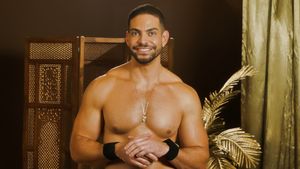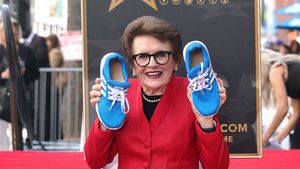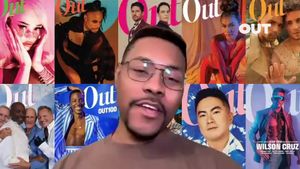It was around midnight when the guest Op-Ed by actress and human rights activist Angelina Jolie went up on the New York Times website. Within minutes I had posted the link on Twitter and emailed friends on the West Coast about it.
The 37-year-old Oscar-winning Jolie has been called the most beautiful woman in the world by People magazine, the Sunday Times and Vanity Fair. She is also undoubtedly one of the world’s sexiest women, appearing at the Oscars in a dress slit up to there.
Her much-touted beauty made her opinion piece titled "My Medical Choice" truly shocking. Jolie revealed she had undergone a prophylactic double mastectomy after discovering she carried the same genetic marker for breast cancer as her mother, actress Marcheline Bertrand, who died of the disease at 56 after a decade-long battle.
Jolie explained that she had made the decision for her children: She didn’t want them to fear losing her the way "Mommy’s mommy" had been lost.
With a mix of sadness and awe, I read Jolie’s description of how she chose to have her breasts removed, including the process of testing to see if she could keep her nipples (the diciest part of reconstructive surgery), the insertion of drains and then the rebuilding of her breasts so that they looked the way they had before with just a few scars.
I had just turned 26 when a persistent irritation in my right breast sent me to the doctor. I remember the look on her face as she examined me. I turned my head to look away from her and saw my lacy black bra draped over my blouse on the chair.
When I was dressed she told me, "There’s something. You need to get it checked." I got out my date book–-as a reporter, I had little free time during the day.
She put her hand out and pushed it down.
"No, now," she said.
I was sent to a different part of the hospital to see another doctor–to this day I don’t remember what he was–gynecologist? Breast specialist?
I lay flat on the table, my apprehension mounting, as he examined me. He pulled a plastic card out of his pocket and held it up. It had graduated-sized holes in it. He pointed to the largest one on the card, about the size of a small plum or a child’s fist.
"You have a tumor this size," he said, with less drama than if he were telling me I had a tear in my stocking. "You need to see a surgeon right away."
Then he left the room.
I lay there for a minute, maybe more. Tears ran down the sides of my face into my hair and onto the paper covering of the exam table. I never felt that tumor in my breast. I had only been aware of a tugging sensation beneath the underwire of my bra.
Within an hour’s time I was sitting in a surgeon’s office with a big manila envelope in my lap that held the images from my first-ever mammogram. It was a little after five in the afternoon.
The surgeon told me I would need to have surgery right away. Again, I pulled out my date book and again, a hand went out to push it down as she said, "I’ve cleared my schedule for tomorrow morning, first thing."
Not more than 12 hours later, in that cruel dark before dawn, I took a cab back to the hospital and had the first of what would be several breast surgeries.
I didn’t have the test Jolie had. I did know that there was a history of cancer in my family, but I was unsure what it was exactly, because the silence around cancer in my parents’ generation was still entrenched. I did know that my great aunt had breast cancer and that my father’s grandmother had died of it when my grandmother was a small girl–the only girl in a family of brothers. I knew that she had literally died screaming in agony in the bedroom of my grandmother’s house.
Even as a feminist and a reporter, that’s what I knew about breast cancer at 26. That my great-grandmother died at 37, screaming, as my seven-year-old grandmother listened downstairs.
No one suggested to me that I have a prophylactic mastectomy. I was only 26, and my surgeon, an attractive woman who was also a sculptor and always wore pearls in the operating room ("The one time I didn’t, things went badly.") told me I would be fine, she had gotten it all out.
I saw the tumor. It was in a plastic container and was, just like I envisioned that large hole in that doctor’s little card, the size of a small plum or a child’s fist. But it was out of me. In its place was a drain with a bulb at the end that leaked blood and lymphatic fluid for a week or so. My surgeon had told me I was lucky, the tumor was up against my chest wall, which meant she could cut me from the underside of my breast, so that the scar would be hidden.
It took a full 18 months–just long enough for me to get confident and comfortable–for the tumor to grow back.
This time the surgery was more intense, and my bravado less.
I was still only 27.
It was less than a year before my third breast surgery. This time my surgeon told me that I would need an implant, which I had previously avoided. "Do I have to?" I asked, because I had heard about silicone migrating and the implant worried me.
Yes, she told me, otherwise my breast would look "like a windsock."
We opted for saline.
I was fortunate. I had no recurrences for years after that third surgery. The last time I saw her, she told me I was "golden" and she thought I would be okay.
A year later she was diagnosed with breast cancer, herself.
Facing cancer makes you an activist. It’s what happened to Angelina Jolie and it’s what happened to me. I needed to know more than my great-grandmother’s horrific story, needed to know more than what it must have been like for her and for my seven-year-old grandmother.
The personal was political for me. I began investigating cancer and lesbians. I discovered that the only stats were bad ones: Lesbians had an increased risk due to our tendency to be overweight, to not have given birth and to drink and smoke more than our heterosexual peers. I spoke to doctors and cancer survivors. I wrote articles–the first on lesbians and cancer–which appeared in
The Advocate and
Out. A friend who headed the Mautner Project for lesbians and cancer in Washington, D.C. asked me to do a book on cancer.
Coming Out of Cancer: Writings from the Lesbian Cancer Epidemic won a series of awards and brought the issue of lesbians and cancer into the spotlight.
Angelina Jolie personalized the issue of breast cancer by taking not just the bold and courageous step of having this painful and frightening surgery, but speaking out about why she came to this decision. As a beautiful, sensual woman, she also told the world that the surgery hadn’t changed her or made her feel like less of a woman. She also said that having the surgery lowered her risk of getting breast cancer from 87 percent to five percent.
In other words, it saved her life.
One of the things Jolie’s story reveals is the cost of cancer–not just in lives and loss, but in dollars. Prophylactic surgeries are not always approved by insurance and even with insurance can be costly. As Jolie herself states, the genetic testing alone is several thousand dollars.
Only a small percentage of women have the BRCA1 genetic marker for breast cancer. The rest of us who get the disease may have different family histories or none at all. Which means we need regular mammograms and ultrasounds and doctors to send us off to surgeons if we need them.
In recent months efforts by Republicans in Congress have curtailed funding for women’s health care, including free mammograms for low-income women. In 2013 few people are unaware of the importance of regular mammography and how it saves lives by detecting cancers at their earliest stages. But as my experience illumines, women under the age of 40, the mandated age to begin having mammograms, can get breast cancer, too.
Which is why health care for women is so vital. I had a doctor. I went to see her. She sent me to a specialist. He sent me to a surgeon. In the course of 12 hours I went from seeing a doctor about a slight irritation to having life-saving surgery.
But that sequence of events required having insurance, having a doctor, having the kind of medical care that saved my life.
Many women don’t have health insurance at 26 or even at Jolie’s age. Obamacare allows parents to keep their children on their health care plans till age 26, but not after. And while next year there will be penalties for not having health insurance, that doesn’t mean everyone will have it or that all insurance will be comprehensive coverage.
As Jolie points out, women have to empower themselves with regard to their health and their future. Be proactive. Do regular breast exams and if you don’t know how, there are instructional videos online. Or have your doctor show you. If you don’t have a personal physician, get one. If you don’t have health insurance, check to see if your state has a program for low-income women.
Take charge of your health as much as you can. Eat a diet high in antioxidants and other cancer-fighting properties. Quit smoking. Maintain your weight. Exercise. Reduce your stress. Play.
Don’t put off seeing a doctor if something feels wrong. You shouldn’t be aware of your breasts–if you are, like I suddenly was of my right breast, that’s a sign.
Many cysts and tumors are benign. Not every lump will be cancer. But some will be. Having surgery, and in some cases, radiation and/or chemotherapy can cure many cancers. Still, early detection is imperative.
Angelina Jolie took a dramatic step to save her life and make her kids feel safe. For me, circumstance forced me to become my own advocate. Both Jolie’s experience and my own led us to spread the word for other women.
Facing cancer is terrifying–whether it’s Jolie watching her mother die over the course of ten years and knowing she could share the same fate or me lying there imagining my great-grandmother’s horrifying death.
Jolie had time to consider her options about the possibility of cancer. I didn’t have time to think–I could only act.
Surviving cancer makes you want to help other women survive it, too. Jolie says she felt empowered by her choice. I felt empowered by informing other women.
Take charge of your health. One in eight women will get breast cancer. Let’s do whatever we can to make sure that the one who does–and it could be you–survives.
@VABVOX
Victoria A. Brownworth is a Pulitzer Prize-nominated journalist and the author/editor of more than 30 books including the award-winning
Coming Out of Cancer: Writings from the Lesbian Cancer Epidemic.Like SheWiured on Facebook.
Follow SheWired on Twitter.
















































